Handcar

A handcar (also known as a pump trolley, pump car, jigger, Kalamazoo,[1] velocipede, or draisine) is a railroad car powered by its passengers, or by people pushing the car from behind. It is mostly used as a maintenance of way or mining car, but it was also used for passenger service in some cases. A typical design consists of an arm, called the walking beam, that pivots, seesaw-like, on a base, which the passengers alternately push down and pull up to move the car.
History
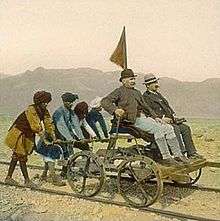
It is not clear who invented the handcar, also written as hand car or hand-car. It is likely that machinists in individual railroad shops began to build them to their own design. Many of the earliest ones operated by turning large cranks. It is likely that the pump handcar, with a reciprocating walking beam, came later. While there are hundreds of US patents pertaining to details of handcars, probably the primary designs of mechanisms for powering handcars were in such common use that they were not patentable when companies started to manufacture handcars for sale to the railroads.
Handcars were absolutely essential to the operation of railroads during a time when railroads were the primary form of public transportation for people and goods in America, from about 1850 to 1910. There may have been handcars as early as the late 1840s but they were quite common during the American Civil War. They were a very important tool in the construction of the Transcontinental Railroad. There were many thousands of them built. They were commonly assigned to a "section" of track, the section being between about 6 to 10 miles long, depending upon the traffic weight and locomotive speed experienced on the section. Each section would have a section crew that would maintain that piece of track. Each section usually had a section house which was used to store tools and the section's handcar. Roughly 130,000 miles of track had been constructed in America by 1900. Thus, considering there was a handcar assigned to at least every ten miles of that track, there would have been a minimum of 13,000 handcars operating in the United States. This number is obviously a gross underestimate because many sections were shorter than 10 miles and railroads also had spare handcars for use in unusual circumstances. Telegraph company Western Union and other rail-users had their own handcars, adding to the overall handcar population.
The first handcars, built in the railroad shops, were probably made of whatever parts the shops had around or could easily make. These cars were probably quite heavy. Weight is the enemy with handcars. Heavy handcars need more people to propel them. More people will add more power but at some point the benefits are offset by the weight of the people: their own weight would not be compensated by any extra power they can produce. Many companies made handcars in the years following the American Civil War as evidenced by the number of advertisements in contemporary publications such as The Car Builder's Dictionary. By the mid 1880s The Sheffield Velocipede Car Company, The Kalamazoo Velocipede Company and the Buda Foundry and Manufacturing Company were the three large companies who were the primary builders of handcars. Sheffield was almost immediately acquired by industrial giant Fairbanks Morse. All three companies changed their names over the years but for most of the years that they produced handcars, they were still identified as Sheffield, Kalamazoo and Buda. Hand cars continued to be available through the first half of the 20th Century. Fairbanks Morse was still offering a handcar from their catalog as late as 1950 and Kalamazoo sold them until at least 1955.
While depictions on TV and in movies might suggest that being a member of a handcar crew is a joyride, in fact pumping a traditional handcar with bronze bearings rather than modern roller bearings can be very hard work. The disagreeable nature of this experience must have been heightened by the dead weight of typical section crew supplies such as railroad spikes, track nuts and bolts, shovels, pry bars of various sorts and other iron and steel equipment.
Motor section cars began to appear in the very early 1900s, or a few years earlier. They quickly replaced most of the handcars. Those handcars that were not scrapped during World War I, were probably scrapped during World War II. It is not clear how many handcars survived. They can be found in railroad museums and some are in private hands.
Modern usage

Handcars have been normally used by railway service personnel (the latter also known as Gandy dancers) for railroad inspection and maintenance. Because of their low weight and small size, they can be put on and taken off the rails at any place, allowing trains to pass. Handcars have since been replaced by self-propelled vehicles that do not require the use of manual power, instead relying on internal combustion engines or electricity to move the vehicle.
Handcars are nowadays used by handcar enthusiasts at vintage railroad events and for races between handcars driven by five person teams (one to push the car from a halt, four to pump the lever). One such race, the Handcar Regatta, was held in Santa Rosa, California from 2008 to 2011 and other races are held in Australia. See the section on racing below. Aside from handcars built for racing, new handcars are being built with modern roller bearings and milled axles and crankshafts.
International
Australia
In Australia, hand cars or pump carts are commonly referred to as Kalamazoos after the Kalamazoo Manufacturing Company, which provided many examples to the Australian railway market.[1] Many Kalamazoos are preserved in Australia, some even being used for races.[2]
Guatemala
There is a push car service along the railroad tracks between Anguiatú in Guatemala and rural towns across the Salvadoran border. Sometimes it is pulled by a horse.[3]
Japan

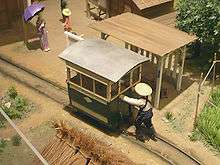
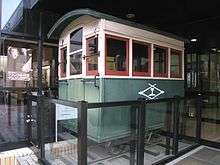
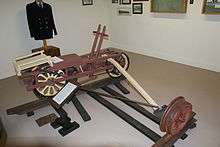
In Japan, dozens of commercially operated handcar railway lines, called human car tramway (人車軌道 jinsha kidō) or human car railway (人車鉄道 jinsha tetsudō) existed in early 20th century.[4] Those lines were purely built for its passenger/freight service, and "drivers" pushed small train cars all the way. The first line, Fujieda-Yaizu Tramway, opened in 1891, and most of the others opened before 1910. Most lines were very short with less than 10 km lengths, and the rail gauges used were either 2 ft 6 in (762 mm) or 2 ft (610 mm). As the human-powered system was fairly inefficient, many handcar tramways soon changed their power resources to either horse or gasoline. The system was not strong against a competition with other modes of transport, such as trucks, horses, buses, or other railways. Taishaku Handcar Tramway ceased its operation as early as 1912, and almost all the lines were already closed before 1945.
List of handcar tramways in Japan
- Hokkaidō
- Ebetsu Town Handcar Tramway 江別町営人車軌道
- Akita
- Nakanishi Tokugorō Operated Tramway 中西徳五郎経営軌道
- Yamagata
- Akayu Handcar Tramway 赤湯人車軌道
- Iwate
- Waga Light Tramway 和賀軽便軌道
- Miyagi
- Matsuyama Handcar Tramway 松山人車軌道
- Tochigi
- Ibaraki
- Haguro Tramway 羽黒軌道
- Inada Tramway 稲田軌道
- Iwama Tramway 岩間軌道
- Kabaho Kōgyō Tramway 樺穂興業軌道
- Kasama Handcar Tramway 笠間人車軌道
- Chiba
- Mobara-Chōnan Handcar Tramway 茂原・長南間人車軌道
- Noda Handcar Tramway 野田人車鉄道 (linemap)
- Ōhara-Ōtaki Handcar Tramway 大原・大多喜間人車軌道
- Tōkatsu Handcar Tramway 東葛人車鉄道
- Tokyo
- Taishaku Handcar Tramway 帝釈人車軌道
- The current Keisei Kanamachi Line.
- Taishaku Handcar Tramway 帝釈人車軌道
- Gunma
- Satomi Tramway 里見軌道
- Yabuzuka Stone Tramway 藪塚石材軌道
- The part of the current Tōbu Kiryū Line.
- Kanagawa
- Zusō Handcar Tramway 豆相人車鉄道
- Also in Shizuoka.
- Zusō Handcar Tramway 豆相人車鉄道
- Shizuoka
- Fujieda-Yaizu Tramway 藤枝焼津間軌道
- Nakaizumi Tramway 中泉軌道
- Shimada Tramway 島田軌道
- Fukui
- Hongō Tramway 本郷軌道
- Okinawa
- Okinawa Handcar Tramway 沖縄人車軌道
Taiwan
In Taiwan, commercially operated handcars were called either light railway line (Traditional Chinese: 輕便線; Hanyu Pinyin: qīngbiàn-xiàn), hand-pushed light railway line (手押輕便線; shǒuyā qīngbiàn-xiàn), hand-pushed tramway (手押軌道; shǒuyā guǐdào), or most commonly, hand-pushed wagon (手押臺車; shǒuyā táichē).[4] The first line was built in the 1870s. The network developed later under Japanese rule. In 1933, its peak, there were more than 50 lines in the island with 1,292 km network, transporting local passengers, coal, factory products, sugar, salt, bananas, tea leaves, and others. Most lines, excluding those in mines and isolated islands, have disappeared after Japanese have left. However, a few lines survived well until the 1970s. Currently, only the sightseeing line in Wūlái still exists, although its line is not human-powered anymore.
In popular culture
Handcars are a recurring plot device of twentieth century film, both comedy and drama.
- The opening scene of Blazing Saddles, set at a railroad construction site, features a handcar.
- In the movie Mad Max Beyond Thunderdome, the culminating chase scene takes place along a railway, with one of the pursuers chasing the heroes down the tracks on a handcar.
- In the Dad's Army episode The Royal Train, the Walmington-on-Sea Home Guard platoon find themselves stuck on a runaway train. Warden Hodges, the vicar, the verger and the town mayor chase them using a handcar.
- In the movie O Brother, Where Art Thou?, the three main characters encounter an old blind man on a handcar after escaping from prison and in the conclusion of the movie.
- In the movie The Great St Trinian's Train Robbery two St Trinian's schoolgirls use one to move between distant points levers.
- In the Coyote and Road Runner episode "Rushing Roulette" (1965) Wile E. Coyote attempts to catch the Road Runner using a handcar.
- In 1998, Sega manufactured the handcar-themed arcade game Magical Truck Adventure which the player controls by pumping a large handle.
- Buster Keaton uses a handcar during a chase scene in the film The General; he also uses a powered drasine in The Railrodder
- In the Simpsons episode "500 Keys", Marge chases a toy handcar called the "Pooter Toot Express". The two figures pumping the car pass gas every time they pump.
- In "Reds (film)" (1981) John Reed, played by Warren Beatty, attempts to leave Russia via a velocipede but is detained by Finnish troops at the border.
Racing
An annual handcar race, Dr. E. P. Kitty's Wunderkammer, featuring the Great Sonoma County Handcar Races (formerly known as The Hand-car Regatta), is held in the rail-yard in old downtown Santa Rosa, California.[5]
A multi-faceted festival, it was centered in races of numerous widely varying human-powered vehicles operating on railroad tracks. These included traditional hand-powered carts and others powered by pedals or pushing.
A similar race is happening in the nearby Northern California town of Willits, California, on Sept. 8 and 9, 2012.[6] Other races are held in Australia, some using preserved old handcars. See the reference above discussing Kalamazoos in Australia.
Additional images
 Handcar or Velocipede at the Nevada State Railroad Museum
Handcar or Velocipede at the Nevada State Railroad Museum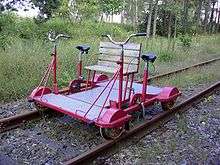 Rail-cycle with 4 wheels. A single bicycle may also be modified with an outrigger and locating wheels to operate upon rails
Rail-cycle with 4 wheels. A single bicycle may also be modified with an outrigger and locating wheels to operate upon rails A handcar, in original condition (at the Shelburne Falls Trolley Museum). The foot brake operating mechanism may be seen between the wheels.
A handcar, in original condition (at the Shelburne Falls Trolley Museum). The foot brake operating mechanism may be seen between the wheels.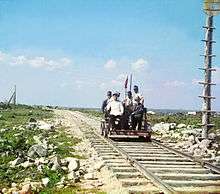
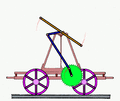 Animation of a Handcar, based on a patent by George S. Sheffield
Animation of a Handcar, based on a patent by George S. Sheffield
See also
- Draisine
- Human-powered transport
- Railcar
- Some rowing cycles are inspired by early handcars
References
- 1 2 "Kalamazoo Railroad Velocipede and Car Company, Kalamazoo, Michigan, U.S.". Retrieved 2008-03-22.
- ↑ "Cummins Kalamazoo". Annual handcar race event at Cummins, South Australia. Retrieved 2008-03-22.
- ↑ Push Car between Guatemala and El Salvador. https://www.youtube.com/watch?v=Inmaq5w4TU0
- 1 2 These English names are just tentative translations for this article.
- ↑ "Great West End Hand-Car Regatta". Retrieved 2009-09-28.
- ↑ "Hand Car Time Trials--Willits Kinetic Carnivale". Retrieved 2012-07-29.
External links
| Wikimedia Commons has media related to Handcars. |
- PRR Hand Car diagrams
- History and other information from handcar.net
- The Hand-Car Regatta Race
- Folsom Handcar Derby 2014
- Racing at the Willits Kinetic Carnivale
- Railriders Video produced by Oregon Field Guide
- (Japanese) 全国人車鉄道一覧 (List of Handcar Tramways all Japan)
- (Japanese) 友蚋炭坑人車軌道 (Yǒuruì Coal Mine Handcar Tramway): About the handcar railway line in Taiwan.